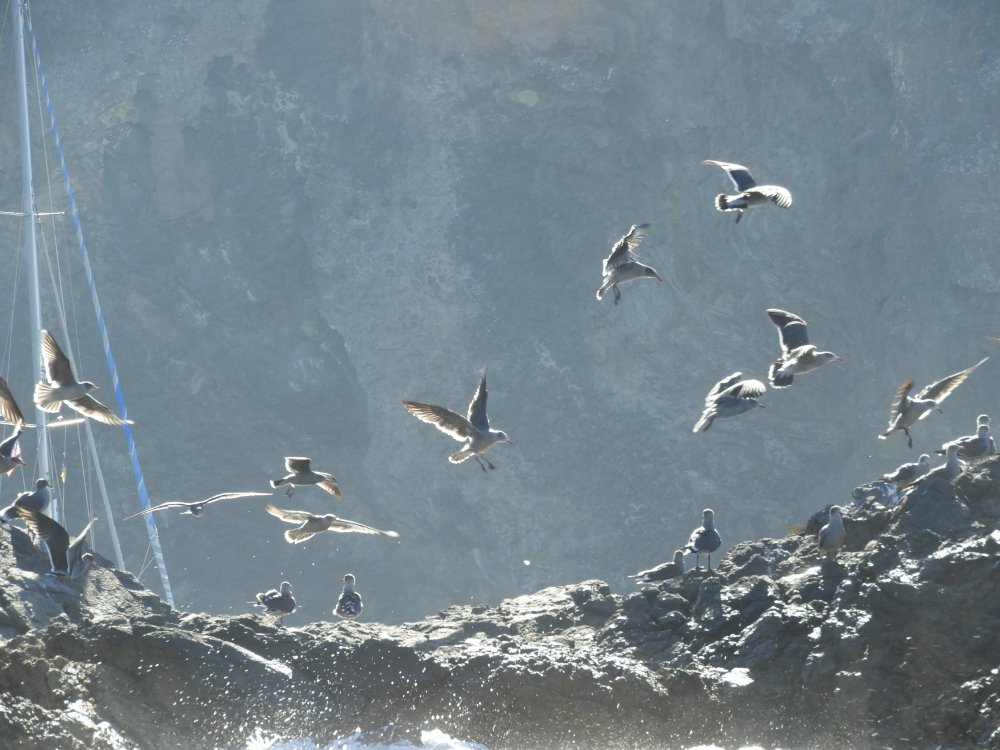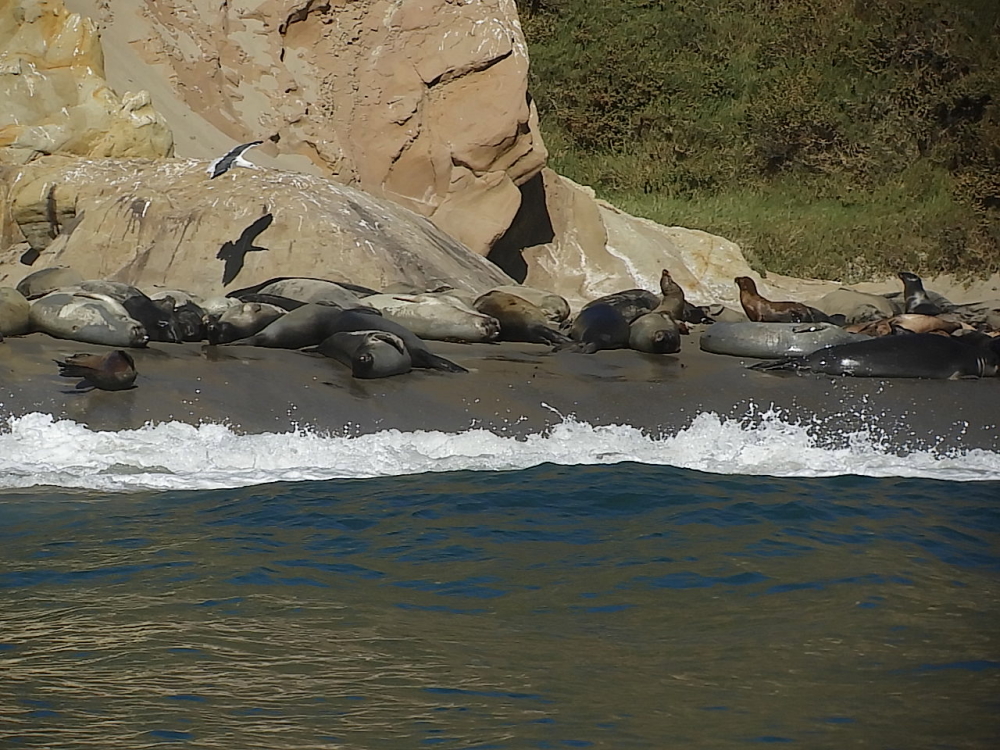
Leaving San Francisco Bay behind as we motored under the Golden Gate Bridge, we had feelings of excitement for our next six weeks of cruising. We had explored the Bay thoroughly, enjoyed the company of the people that we met with the city break and vineyard trip being the icing on the cake.
Pillar Point Harbour was our next anchorage, tucked into the northern corner of Half Moon Bay. This harbour has impressive inner and outer breakwaters for good protection from the mighty Pacific and the home of the largest fishing fleet in Northern California. Half Moon Bay town is almost 5 miles away via Highway 1. First and lasting impressions were a huge amount of money had been poured into this harbour-side village, mostly empty buildings, the odd surfer/fisherman’s bar, fast food and the odd empty gourmet restaurant. It is hard to describe the emptiness of this place despite some of the bars being busy.
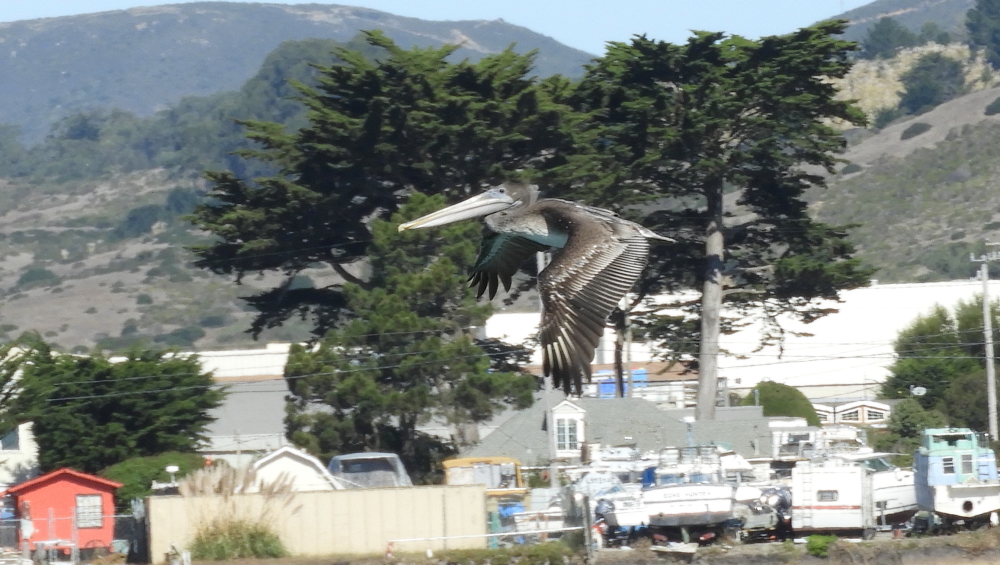
The thousands of Brown Pelicans crowded the rocky breakwaters, protected by the wind, pushing gulls off into the sea and the smell of ammonia was overpowering. Barking Sea lions together with the constant fog horn went on 24 hours a day, but we are used to these sounds and they don’t disturb us. During our time there, the world’s largest Pumpkin Festival was on and Debbie dragged Leo and Stephen on public transport to the main town. Gourds of every colour, size, shape and weight were displayed in the fields, on stalls and in the backyard of an animal feed merchant. Thousands of people wearing orange or adorned with Pumpkin jewellery and hats mooched around the many craft stalls. The US largest Pumpkin was on display but Leo was tickled when he found out the largest in the world this year was grown in Holland. After a few hours and the need for a beer, we departed having experienced our first Pumpkin Festival and maybe our last!
Whilst sailing off this coast we enjoyed constant sightings of Fin Whales, sometimes getting their aroma before we saw their blow. The first day we were surrounded by them, some alarmingly close.
An overnighter in Santa Cruz Harbour just off the pier where we were entertained by the Sea lions jostling for space on the pontoon beneath the pier structure. Many fell in to the sea with some of the younger, lighter ones launching themselves out of the water like a torpedo and landing with a thud on the pontoon, only to be pushed in again.
Our time with Leo and Bubbles was coming to an end in Monterey but not without spending some time exploring the area together, enjoying meals on one another’s boats and generally relaxing.
Monterey was once the capital of California whilst under Mexican rule until 1846, now a chic small city (population of 29,000) spilling onto the gorgeous sandy beaches overlooking the huge crescent shaped bay which is a protected marine sanctuary. We spotted a pod of Orcas as we got closer to the anchorage and once again the Pelicans were doing flypasts. The pontoons and breakwater were heaving with boisterous Sea Lions and Cormorants, no space for the Pelicans here, with the Harbour Seals resting on rocks in the shallows or nosing around Amelie.
The Rumsien Indians inhabited this peninsula for thousands of years, moving their settlements seasonally for their animal, fish and plant requirements. The Europeans drastically changed their native lifestyle, with their traditional food supplies being heavily harvested by the population explosion and clashes between the two cultures regarding beliefs and traditions. European diseases decimated the native population and wiped out entire villages. The Spanish missions under the Franciscan order started in 1770 in this area and expanded up and down the coast. The Mexicans took over in 1821 and opened the port to foreign traders, collecting custom duties at the Custom House, which still stands as the first State Historical Landmark in California. In 1846, during the Mexican-American war, US naval forces landed in Monterey and claimed California under the American flag. This coincided with the discovery of gold on the slopes of Sierra Nevada in 1848 and the seat of California was moved to San Jose, which left Monterey isolated until the early 1900s when the city became a thriving fishing and cannery industry. Cannery Row and its buildings are reminiscent of those times. John Steinbeck in his novel “Cannery Row” describes how Monterey operated in the early 1900s with his characters resembling many of the locals at the time. Debbie read “Of Mice and Men” for her English Literature GCSE (O level) so reading more of Steinbeck’s work was pure pleasure for her. As she walked down Cannery Row she could imagine where Doc (Ed Ricketts) did his scientific research, discovered the building in which Lee Chong had his grocery/hardware store and Dora’s questionable establishment. Today the Row is a quaint seaside street, with historical artefacts sprinkled in-between the buildings. Glimpses between lots out into the bay gives the place a summertime feel even when the weather is cool and dull. In the opposite direction the Fisherman’s Wharf is a bustling pier with restaurants and fresh fish stalls, a mixture of tourists and locals going about their day, Whale watching boats and fishermen/women casting their lines into the sea. We couldn’t leave this city without experiencing the world famous scenic coastal, “17-Mile Drive”, from Monterey to Carmel by-the-Sea. Exciting views of the boiling foamy turbulence of the sea as it crashed over the submerged rocks and against the rocky foreshore as we meandered along this protected toll road. The golf course and odd resort dotted along the route were not that important to us but the drive through Del Monte forest was amazing. We passed famous landmarks like the lone Cypress tree, Cypress Point, the Ghost tree, Pebble Beach, Point Joe (shipwreck cove) and many others. Time before the car, horse drawn carriages were seen along this stretch, established in 1881 by Charles Crocker, people like us enjoying this legendary location. Carmel was full of parked cars and people, so we found the one way scenic route and enjoyed the town slightly off the tourist track. Carmel has a mixture of high end designer boutiques and gift shops housed in architecturally interesting buildings. It seemed that each house, shop premises, garage etc was different from its neighbour. An eclectic town with a Spanish aura and a hint of Bavaria but far to touristy for us.
During our time in Monterey, we heard of Humpback Whales entering the marina, blowing and exiting. Our dinghy rides between Amelie and Bubbles, we came across a fat Sea Otter, always eating lying on its back, using its front paws to hold the fishy morsel, periodically dipping its head in the water to clean its mouth. Staff at the marina described how these Otters are very playful and their favourite game is “Toss the Sunfish” ……..not great for the Sunfish! Stephen read that at night they tether themselves to the kelp to keep them anchored whilst they sleep. Kelp (a friend described Kelp as an inshore choker) delayed us leaving the anchorage by holding fast to the anchor and after 55 minutes of energetic pulling, tearing, beating with the gaff hook, using colourful language and changing Amelie’s direction using the bow thruster, we eventually freed Amelie of the rubbery incarceration.
The “barn doors” were erected and we had a magnificent downwind albeit cold sail towards the Channel Islands with the bonus of sighting several Albatross, gliding amongst the gulls and Pelicans, passing the treacherous Point Conception (also known as the “Cape Horn of the Pacific”) whilst the sea and wind went calm. The air was dryer and noticeably warmer as we got nearer the Channel Islands.
The islands are named for the deep troughs that separate them from the mainland of Southern California. Chumash Indians settled on the northern islands, trading up and down the coast until the Europeans arrived in 1542 and later in 1793. The Chumash were moved to the mainland by 1822 with ranches being the main feature on the islands. By the 1900s the island ecology had been devastated by the introduction of non native animals and plant life but slowly the islands are returning to their former natural beauty. There are four northern islands and one southern island that visitors may visit. Several of the southern islands are military territory with no civilian access and the evidence of the military is obvious by the daily announcements on the VHF of “live firing” in certain zones. The Channel Islands are a national park and a marine sanctuary with many strict rules. The weather patterns that flow over the islands can be challenging with the notorious Santa Ana winds a feature in the fall and winter. These local violent NE, hot, desert winds can travel offshore for long distances. We had been advised to check for lack of dew on the decks, exceptional visibility with hot air (similar to a hot hairdryer setting) and a seaward dust indicating that Santa Ana's are coming.
Apart from the unspoilt beauty of these islands we had not expected to see another form of wildlife…..Northern Elephant Seals in their rookeries on the sandy beaches and dunes. We were woken by the amplified nasal communication between the Bulls, with their extended proboscis. Stephen likened the sound to that of a Bull frog on steroids! We witnessed Bulls fighting one another for dominance of the females as it was coming up to mating season and pups building up their confidence in the water. The great hulks moved (like a giant slinky) surprisingly fast along the foreshore to get to another Seal or tumbling in the surf with others further up the beach, flicking sand over their bodies to keep cool or disperse the flies. Elephant Seals are accomplished divers and spend most of their lives in the water. As the sun was setting we witnessed many of the juvenile seals returning from their fishing trip to their rookeries. The Channel Islands have the largest population of these mammals in the world. Some of them were naturally inquisitive and swam out to Amelie, lifting the top third of their bodies out of the water gazing at us with huge doe eyes. Whilst lifting the anchor in Cuyler Harbour, San Miguel, the chain was swarming with spidery starfish which were dispensed overboard……one seal was particularly grateful to us for this easy snack. We were under the impression by the guidelines that fishing was prohibited in the waters off the islands……apparently not as each day the sports fishing boats with their crews emptied and reset lobster pots in accepted zones. Another activity in the region was the Pacific Naval fleet practising firing. The double boom and the vibration of the air as the short term firing progressed was in contrast to our beautiful surroundings and nature. An enigma!
Whilst in Johnson’s Lee, Santa Rosa we had our first swim in the cool Pacific waters after 18 months. We didn’t bother with wetsuits as recommended in the pilot books as us hardy Brits were brought up with icy swims in the UK. However we were surprised how refreshing the water was and the freedom of jumping off Amelie to enjoy one of our favourite pastimes made us giggle like children. Time for Debbie to try out her new snorkel which caused hilarity back in Canada.
Time to move on to the next island, Santa Cruz, the largest island in the northern chain and plenty of anchorages to choose from in any weather, although the forecast suggested calm weather for the following three days. As we travelled between the islands, adjacent to Skunk Point, we saw a frenzy of hundreds of seals, birds and dolphins coming from all directions, fishing together. We hadn’t seen anything like it before on our travels.
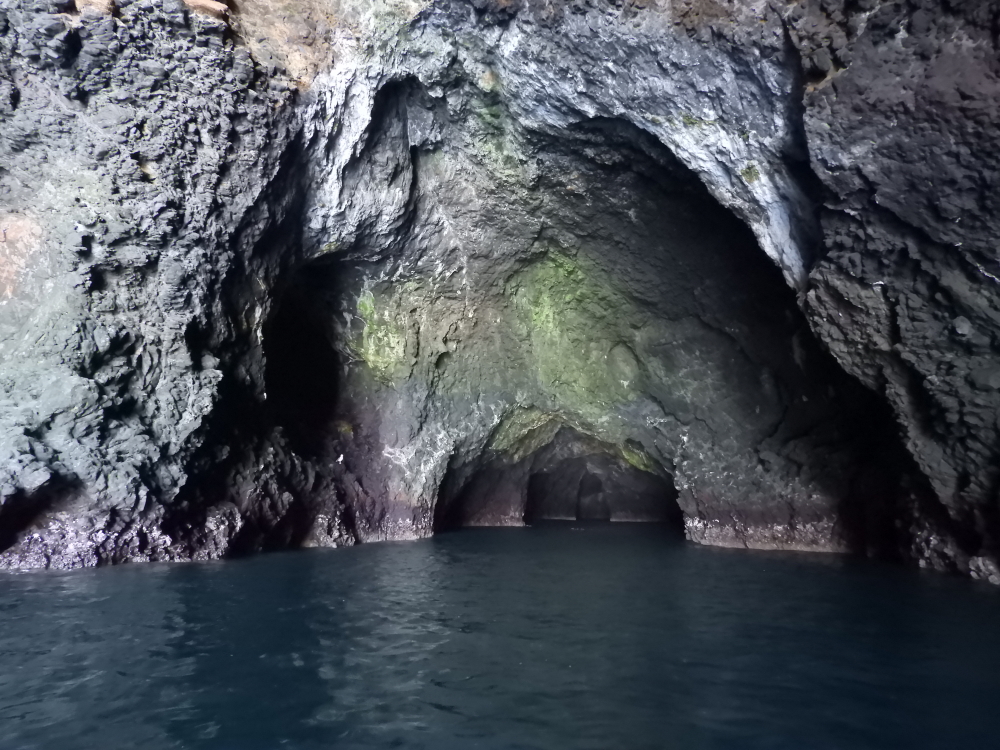
Cueva Valdez anchorage is a tiny anchorage protected by sheer cliff faces with sea caves eroded at the base, a small beach with stunning views up the canyon, dotted with shrubbery and small trees. We experienced fog during our trip to this anchorage and a bank remained throughout the day on the horizon, meanwhile the sun beat down on us in the anchorage. A medley of seabirds were roosting together on a jagged rock facing out to sea, with a few sea lions basking near by. The water was crystal clear with very little vegetation in the water but unfortunately roly with a powerful surge as the tide retreated. Nevertheless we used this anchorage as a base for taking “M” along the coast to visit the “Painted Cave”. The vaulted ceilings of this cathedral shaped cave system were a mass of green, purple, rusty red and pinkish hues. Ferns clung to some of the overhead rocks and the echo of a rookery of Sea Lions barking on our approach. As we entered the cave system, many of the juvenile sea lions were floating on their backs with their fore and hind flippers aloft, tumbling over and swimming beside and underneath us while the older ones were sunning themselves on the rocks. We cautiously manoeuvred into the cave as far as we could go and then returned when waves were surging into the narrow tunnel. A unique experience.

Due to the surge in Cueva Valdez we decided to up anchor and motor along the coast to Little Scorpion anchorage, amazed by the erosion “art” of the coastline…..arches, blow holes, steep triangular canyons, anvil shaped lone rocks, windows through the cliff face and more sea caves.
We had the fortune to meet a lovely family here, Alan, Jennifer and Katie. The parents hailed from the marine biology sector and shared much information with us. We enjoyed their company on Amelie and their catamaran, Goblin with illuminating conversations not just about boats and sailing.
We enjoyed kayaking in this area with a trip ashore for hiking and meeting some of the unique species on the island. The Island Scrub Jay is a rare bird only found on the island with deep blue feathers and a light mushroom coloured breast. We witnessed one extracting grubs from a Eucalyptus tree, fascinating sight.
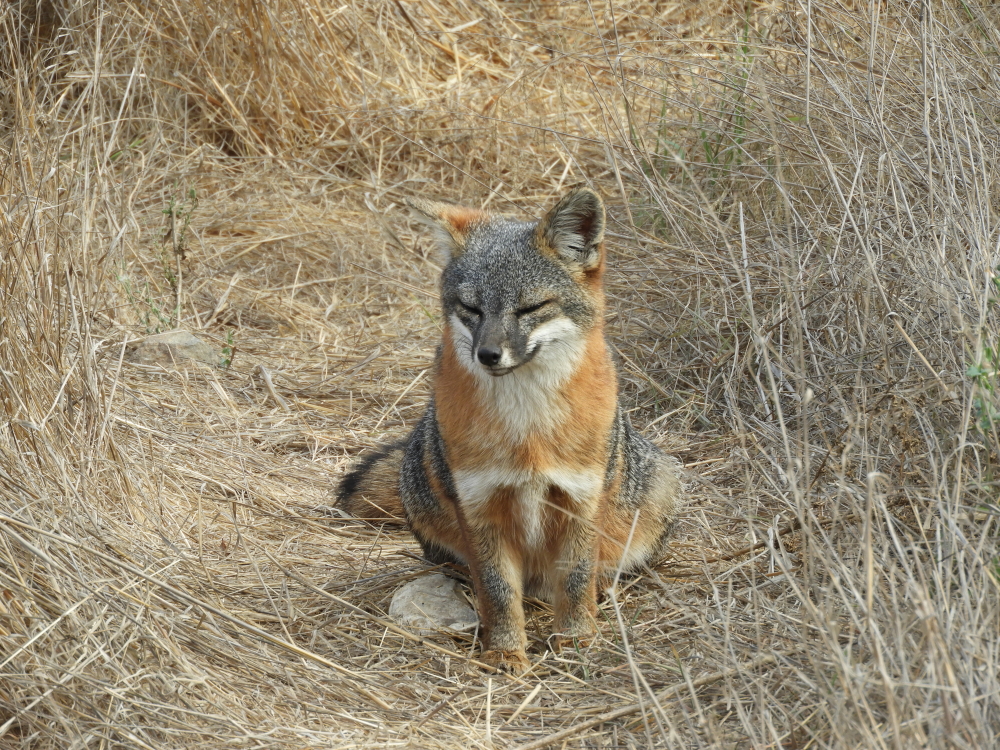
Debbie’s favourite were the Santa Cruz foxes…..the size of a large domestic cat with beautiful colouring finishing in a black mohican along their brush. Busy little beings, extremely interested in anyone who has food and scurrying to get to their next destination. Alan explained to us that Peregrine Falcons, of which we had seen a couple in the anchorage, dive bombed smaller birds at tremendous speed, hitting them so hard that they were plucked at the same time as being killed. This was described as seeing a ‘whooooooosh of feathers’ and when the Falcon reached the ground to retrieve their prey, they only ate the heart and liver, leaving the jellied mush to other scavengers on the island. Needless to say Stephen was keen to see a “whoosh of feathers” so we went ashore for a longer hike, armed with the camera but although we saw several falcons we didn’t see any at eating time. Meanwhile we sampled Jennifer’s talent at baking, enjoying sourdough bread, biscuits and Stephen’s favourite….moist chocolate cake made with yoghurt. Katie who is twelve amazed us by her voracious reading ability, painting prowess and can that girl row in challenging conditions!
Cigar, tobacco and fresh fruit supplies had depleted so a trip to the mainland was necessary. Oxnard was only 17nm away and Alan had discovered that there was a tobacconist there……no brainer! Our trip across the channel was a pleasure as we had porpoises swimming with us the whole way. After checking in with the harbour master, refuelling and closing off the holding tanks after dropping a dye tablet into the toilets, we motored cautiously to our guest berth, sucking in our breath watching the depth gauge plummet. First venture was to get Stephen’s supply of cigars and tobacco, then explore the waterways. This marina development was huge with colossal, film set type houses with their own pontoon with their electric “Duffys” tied up. Some had Christmas decorations adorning their frontage, names of their boats were imaginative and overall Stephen’s description of the area as a modern Venice was kind……quite surreal. However the WIFI was fast, supermarkets well stocked, West Marine and of course a well supplied tobacconist. Goblin and crew were moored in front of us and once again we joined up for a safari supper and Alan entertaining us with his version of Charlie’s Charts description of Paradise Cove. The guest berths were close to a naval base so as the sun set we heard a lone trumpeter playing “The Last Post” and in the morning, the military band played “The Stars and Stripes”.
During this journey we had a distressing email from Leo to say that Bubbles had sustained substantial damage due to a fire. Luckily Leo and Karin had managed to get off board and from their updates and a lengthy Skype call are spending their time organising getting Bubbles back to her former splendour.
After sampling the delights of Oxnard we departed for the southern coast of Santa Cruz which for us was unexplored on our first trip. We anchored in Smuggler’s Cove (names here are very original!) hoping to get a trip ashore to hike through the olive groves and remnants of an old ranch. Sadly the waves breaking on the beach prevented us from landing the kayak, together with a change in weather, we decided to do an overnighter to the southern Channel Islands, namely Santa Catalina. We arrived in sun and anchored on the outskirts of the mooring buoy field in Emerald Cove, named after the colour of the water. The beach was full of Boy Scouts doing water sports and activities but quiet when the sun started to set. This island is very different from it’s northern cousins….roads, cars, shops, condos, hotels, camps, museum and theatre.
A hike ashore on the designated dirt road allowed us to look down on the coves and we watched an Osprey circling just above us, whistling to his/her mate, alas we didn’t have the camera. The island is greener than the northern counterparts, with some interesting wild flowers and shrubs together with huge cacti. It is reported that there is a herd of Bison on the island, left over from filming decades ago. The sighting of a Catalina Island fox was a bonus, he was as small as his northern contemporary but much darker and appeared to be very shy, scuttling away in the underbrush. Our last night in this cove was spent enjoying Goblin’s company together with another boat in the bay. After a few gins and the odd beer the merriment continued until our sides hurt from laughing. We managed to make some plans for the following days, once again joining Goblin. Our next cove was 4th of July Cove (we have mentioned the originality of the naming of these coves) which was busier since we had arrived on Veterans Day. This cove and several others are situated along the outer shores of Isthmus Cove with Two Harbours at the head. Here we were able to extract some dollars from an ATM, and found a well stocked general store, restaurants, bar, coffee shop, a visitor centre, ferries transporting tourists and backpackers to and from the mainland…Los Angeles and various water sport facilities. Several hikes were taken inland, checking out Catalina Harbour climbing up dry, slippery shale to get to the peak of the headland and past locked up yacht clubs, dotted around the head of the isthmus. Stephen and Alan were playing with communications using the iridium to send messages to one another via satellite despite being 50 feet away. The beauty was the texts between the iridium were free but is there a space footprint? Despite the water being on the coolish side, Debbie snorkelled and saw an Octopus, loads of Garibaldis and a large Abalone. Much to Debbie’s delight was the fact she could swap her books in the local laundrette thereby solving the problem of her not having anything to read. Issues with her iBooks hopefully will sorted out on her return to the UK.
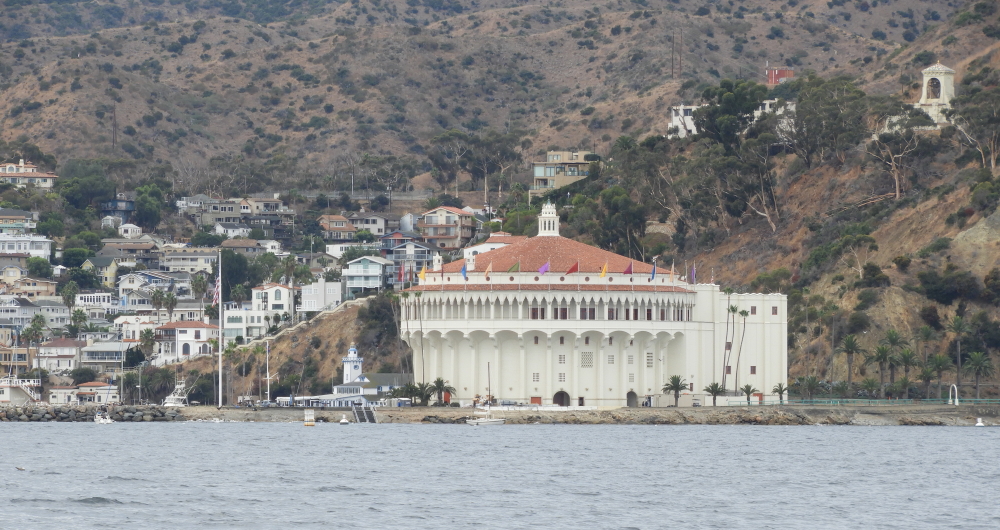
Stephen’s work connection to Wrigleys and the fact that the island was once privately owned by the Wrigley family, encouraged us to anchor in White’s Cove to enable us to dinghy into Avalon and visit the museum for more Wrigley history. White’s Cove was idyllic, with solar powered lanterns on the shore lighting up a path through the palm trees to an empty yacht club. Avalon was a 3nm dinghy trip away and well worth the visit. The first structure we came across was at the top of the dinghy ramp, the massive art deco Casino building which houses a 1920s auditorium and a dance-floor to allow 6,000 people to dance at one time. Unfortunately the building wasn’t open to the masses due to the exorbitant entry fee and limited access during the day. Disappointed we wandered around the quaint harbour along Casino Way, with ceramic tiling in the walls and beautiful golden beaches on the shoreline. Various wooden decorative buildings housed the Catalina Island Yacht club and the Tuna club……no we were not permitted to step inside. The Catalina Island Museum was reasonably priced and we spent time watching the old ‘Pathe” news coverage of the island, amazed by how many silver screen gods and goddesses charmed these shores (Clark Gable, Erroll Flynn, John Wayne, Natalie Wood, Marilyn Monroe, Ronald Reagan, Charlie Chaplin and many others), history of the two fires that almost destroyed Avalon, the military use in WW2 and of course what we came for, the history of the Wrigley’s connection to the island. The first fire was catastrophic and as islanders were unable to financially reconstruct the Wrigley family stepped in snapping up the island for a reduced price and restoring it for the use as a playground for the rich and the poor. The Wrigley family were the patrons of the Chicago Cubs baseball team and their training took place on the island during the summer months. The island was given over to the island conservancy company several decades after the war and continues to function under this company.
Going back to the famous individuals who graced or tainted these shores, the news is chequered. Natalie Wood drowned off the island, Flynn was charged and found innocent of the rape of a young girl destroying her reputation, Mutiny of the Bounty was filmed here and the animosity between Captain Bligh (Charles Laughton) and Fletcher (Clark Gable) was real. Gable hated the fact that Laughton was openly gay and public school; Laughton saw Gable as having poor acting skills with a pretty face for the camera. Gable had concerns that wearing a ponytail and breeches would wreck his image as a film-star but in fact both of them received Oscar nominations for their parts. John “the Duke” Wayne was loved by the islanders and said to be a gentleman who became mischievous when drunk. The actor who played the original Tarzan, Weismuller, was a legend in these parts who loved the sailing in the area and enjoyed showing off his aquatic acrobatics to all.
We were fortunate to view Dale Chihuly’s glass artwork in several of the galleries. The colour, light and form in natural and architectural settings were amazing. Molten glass blown to resemble seashells and underwater shapes, interlinked on black glass tables to allow the light from above to illuminate the sculpture and reflect the image below, thus creating several views at the same time. The outdoor gallery depicted gardens of glass flowers, buds, reeds, sunflowers, lilies etc. Inverted chandeliers of intertwined coloured glass with autobiographical meaning to the artist resembling his childhood memories of the beaches strewn with fishnets and floats and the sun over the Pacific.
The weather report suggested a Santa Ana wind was coming in so the only all weather protected anchorage was on the other side of the island in Catalina Harbour. At dawn we attempted to lift 90 metres of chain and anchor in settled conditions using the windlass to find that it had failed. The following few hours we rigged up a pulley system and using the electric winch in the cockpit together with brute strength we flaked the chain into the anchor locker and secured the anchor. We were interrupted by what we thought was some added strength from a bystander who was only interested in telling us that he had sailed an Oyster, where were we from and wished us luck with the hauling as he motored away! At least he didn’t ask us if we were Australian, which we are asked continuously throughout our time in the USA and sometimes in Canada.
Stephen had to knock the moths out of his wallet and request to moor up to a mooring ball in the harbour, which is something we are cautious of. Mooring buoys are fine when they work but you never know how well they are maintained, what weight they can withstand and we normally trust our “ground tackle”. We had no choice and we were allocated a buoy with the best mooring system we have seen on our travels. There is a fore and aft loop to attach onto the fore and aft cleats of the boat, no swinging, rolling and the harbour can have many more boats (ie more revenue) in their anchorage. We used this stay to get rid of ALL our rubbish.
With an anchor windlass now added to our jobs list and with Thanksgiving looming (no one will be open) we set off at 2am on the Monday morning to ensure we got into San Diego in daylight. Despite having favourable reports of wind at 15-20 knots behind us it all changed at the last minute and we ended up motoring for 14 hours in a dead calm. Our approach to San Diego was exciting as the start of the Lobster fishing season heralded a sea of floats attached to pots. Thank goodness we were in daylight and could thread our way through. San Diego is a major US navy port and amongst the numerous boats and RIBs we witnessed a Dolphin jumping into one of the black RIBs. We learned that they train Dolphins for anti-personnel and mine searching. Stephen bemoaned not having the camera to hand but on hind sight filming navy operations may not have been the brightest thing. As a foreign flagged vessel we had to check into the marine police dock but having logged our progress with US Customs and Border Patrol, as we progressed south, this was a 2 minute ‘phone conversation and we were legal. We got to Chula Vista just before sunset and Amelie is tucked into the marina with boat jobs progressing, our flights booked and now the prospect of our third visit to the UK in 12 months!
